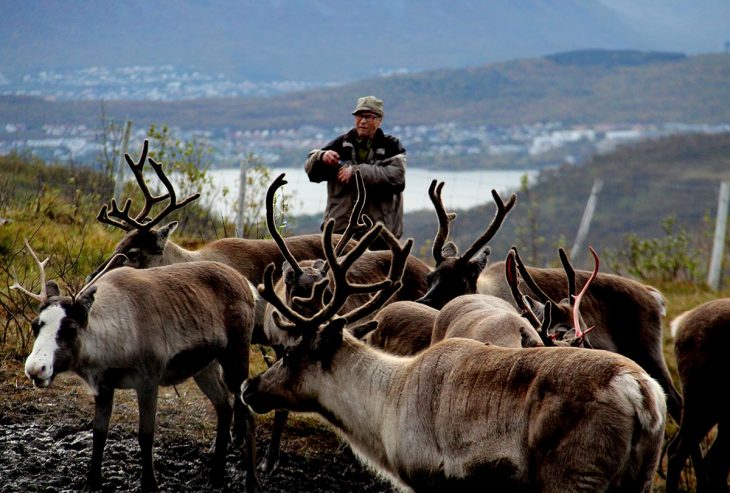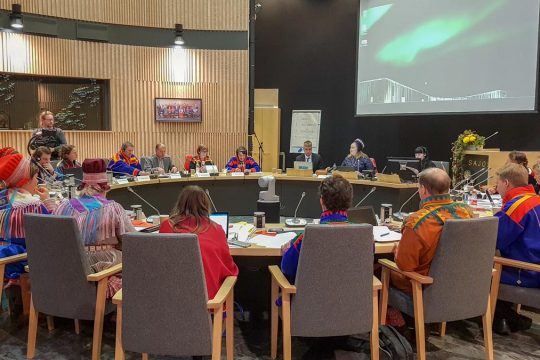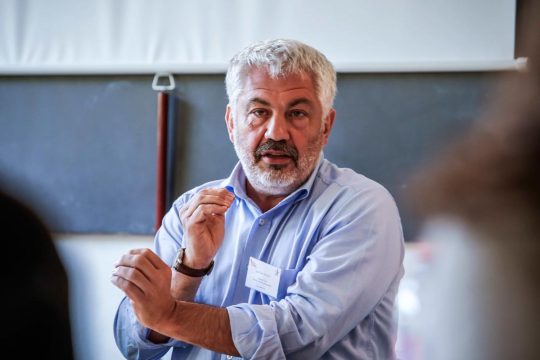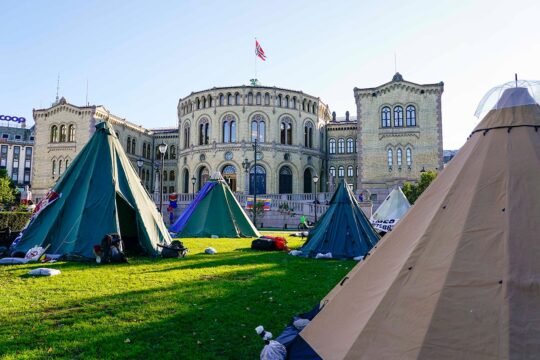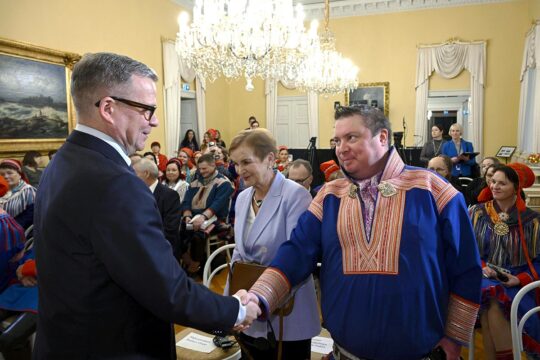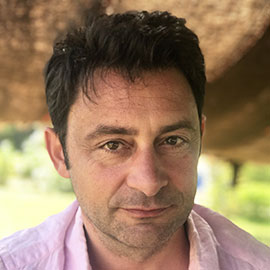We are a stone’s throw from Tromsø, north of the Arctic Circle. To be precise, we are in Kvaløya, "Whale Island", which six years ago saw the death of its last musk ox, a descendant of a species that had rubbed shoulders with mammoths and had taken refuge in the Arctic because of global warming 2000 years ago, already. It was a female musk ox, who died from swallowing the plastic rings of a six-pack of beer. "Norwegianization" killed her but gave her an autopsy and a name: Alma.
Per Kitti's reindeer could soon disappear too, according to him. At 71, this traditional Sami herder is himself a survivor on the island, which has now become civilized with its roads, electricity, and its tens of thousands of beer-loving inhabitants descended from the Vikings. As night falls, Kitti welcomes us to his rectangular wooden cabin. An all-in-one room with a high ceiling, containing a kitchen, sleeping bench and dining table. Around it, over the decades, a suburban city has encircled the sedentary nomad. Slowly, the small, bright-eyed man serves us coffee, rolls a cigarette and fetches from a shelf a photo album, which he looks at sadly. There are pictures of mutilated reindeer, killed by the dogs of other island inhabitants. "After me, reindeer husbandry will die out here," he says.
The next day, with a little luck and a lot of patience, we see his reindeer on a green pasture at the foot of the snowy Kvaløya foothills. As an airplane passes by, the oldest of the herd raises its antlers as it chews.
Brutal "Norwegianization" at school
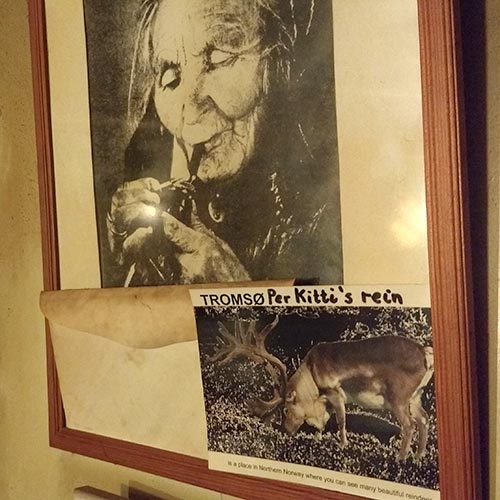
Reindeer husbandry, which occupies less than one Sami in five today, remains a strong marker of identity for Europe's last great indigenous people. The Sami are estimated to number between 80,000 and 100,000 living across Norway, Finland, Sweden and Russia. The coastal Sami also live off fishing. But most of them have mixed with the majority populations, whether by force or willingly. When Kitti was born in 1948, Kvaløya was still a terminus of the annual migration of Sami herders from Sweden seeking the relative warmth of the fjords. These ancestral movements were stopped, for the most part, by borders and the policy of "Norwegianization". “It was my grandmother who decided to settle on this island after the Second World War," says Kitti. Her portrait on the wall of the cabin suggests a strong, pipe-smoking individual. Family legend has it that she was the first to demand money on the market for the skins that Norwegians traded for alcohol and glassware.
This is why Kitti could be an edifying witness for the Norwegian Truth and Reconciliation Commission (TRC), which is charged with "investigating the Norwegianization policy and injustices committed against the Sami and Kven / Finnish Norwegian peoples" from 1800 to the present day. The commission is based in Tromsø, on the other side of a road bridge that did not exist when Kitti was a child. The young Sami used to go by boat to school, where he faced hatred and racism, he says. "I was beaten, called a Lap [a derogatory term for Sami]. It was very hard." Then Kitti did his military service, again being bullied because of his ethnicity. Assimilation, however, was really not for him. “I have to be a Norwegian," he says, "but inside I am a Sami.”
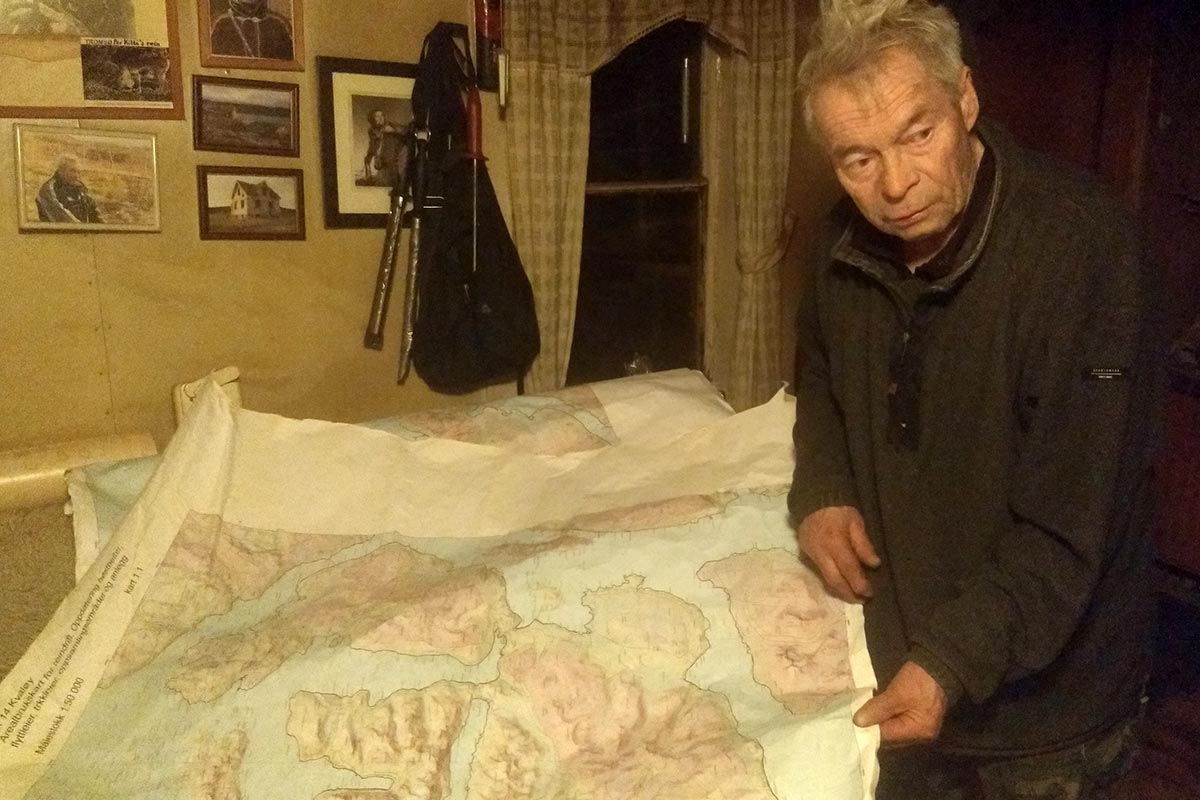
"Norwegian law smacks of racism"
"Today racism continues in a softer, less open way," says Kitti, through laws and the Public Office in charge of reindeer husbandry. That makes him angry. The herdsman unfolds a map of Kvaløya, showing areas of the island where the Office recently tried to contain his reindeer. "The government people came with a contract, with my name at the bottom. I refused to sign it." This was an insult to nature for this man, who has himself been unable to adopt certain "Norwegian" customs like keeping an appointment with a time and place. "We're the ones who follow the reindeer. They're wild animals, you can't do that!"
The incident reminds him of various measures taken in the 20th century to control the reindeer and the indigenous people. Kitti folds up his map, shaking. “Forcing reindeer herding into special zones is racism. The officials are against us. Norwegian law smacks of racism.” He states firmly that “the Truth Commission must examine the laws and their stupidity”. He has already talked to them on the phone. But it is a Norwegian institution and he doesn’t trust it. “They took my testimony but they didn’t listen to me,” he says, looking blackly at his old Nokia phone charging next to his radio and a pile of newspapers. The Truth Commission has not dampened his anger.
Twenty years after royal apologies
On the other side of the bridge, the TRC is slowly starting its work. Its secretariat is at the Arctic University of Norway (UiT) in Tromsø. This town nicknamed the “Paris of the North”, which made its fortune on cod and whale fishing, has become a big cultural and tourism hub of the Far North, a bridgehead for the Norwegian civilization in the vast land. It takes as much time to fly from Paris to Oslo, the capital city, as from Tromsø to Oslo, where the Norwegian Parliament decided in June 2017 to set up this truth commission, going against the will of the conservative government at that time. This came 20 years after official apologies to the Sami people by Norwegian king Harald V. The commission took another year to get its 11 commissioners and chairperson appointed, and nearly a year for the inauguration of its secretariat. At the end of 2019, it had collected only 75 individual testimonies. But its final report is not due until 1 September 2022. The commission has time.
The Norwegian truth commission’s mandate is primarily to document and analyse history. Its main task is to carry out a “historic mapping” of policies implemented against three indigenous peoples of northern Norway – the Sami, the Kven and the Skogfinn (meaning Finns of the forest in Norwegian) – “from around 1800 until today”. Its second task is to examine “repercussions of the Norwegian policy today” and investigate hate crimes and racism against these populations. Its third task is to recommend in its final report to Parliament “measures for continued reconciliation (…) that can create greater equality between the majority and minority population”.
Getting people to talk
The TRC’s first meeting with the public was in September 2019 in Bugøynes, a small fishing village near the Russian border. The Commission still has to make itself known to the majority population and overcome the scepticism of the minorities. But given its university link, its work seems to be supported and studied at the UiT in Tromsø and beyond by numerous academics. Among them is Gunn-Tove Minde, a UiT professor specializing in health issues. Herself a Sami, she is developing programmes on the ground with indigenous people. She says this population has a “need for expanded help with psychosocial problems, low self-esteem and identity dilemmas”. She thinks a big challenge for the Commission will be getting them to talk, when “the norm is not to tell everything in Sami culture”.
Although the Commission is partly composed of people from the communities who speak their languages, Minde wonders how the Commission will be able to collect stories that are kept silent even within families, and how it will then recount them “from a Sami perspective”.“One of the challenges of this commission will be to document stories about boarding schools that are not even shared within the community,” Norwegian film maker Jens Ivar Nergard told a UiT seminar in October. “The more tensed the experience was the less people talk about it. It’s a long way to get it to the surface.”
A “commission of experts” with a “Nordic method”
Kitti wonders why no big Sami leader is in the commission. It is chaired by Norwegian politician Dagfinn Høybråten, former head of the Christian Democrat party. However, a Sami does head the secretariat: Liss-Ellen Ramstad, who has worked for the Norwegian administration and as an advisor to the Norwegian Sami Parliament set up in 1989. “It has been a very public debate about who is going to be in the commission and what kind of commission it should be,” explains Ramstad. “In the end, the Norwegian Parliament decided that it was to be an expert commission.
“They were chosen because they were leading in their different fields. They had a lot of knowledge about Sami or Kven societies or language or culture.” She adds that the initiative was first submitted to the three Sami Parliaments of Norway, Finland and Sweden in 2014. They all wanted a truth commission with a Nordic dimension. But the process went faster in Norway, which is ahead of the other countries.
“We don’t have a model. But we have taken inspiration from previous commission work, especially Canada, on ways of reaching out to people for instance,” she says. “But Canada was very much driven about the compensation part. And that is not a part of our mandate at all. We have also been looking at Greenland. We have similarities. But it was an internal process in Greenland. Our commission is about the whole Sami Kven societies and it was a decision from the Norwegian parliament to go ahead with such work. That’s the biggest difference.”
Finally, she says that “we have developed a Nordic method on how we conduct such work in Norway, that suits our communities. The process is relevant for the whole nation, not just Kven, Sami and forest Finn societies. There is a common history to render visible in Norway.”
Overcoming shame for reconciliation
The commissioners are continuing their jobs and are not full time. Nevertheless, the TRC has gone several times since September to meet the people in the big towns of the Far North and also in Oslo. Victims are not invited to testify publicly during these meetings but in written form or audio and video recordings including of direct individual interviews. They can say whether or not they agree to have their testimonies made public. Sami or Kven associations are invited to speak during these meetings and journalists may attend. The public is not yet turning out in large numbers, with some 80 people coming on average. “But we get a lot of invitations from all over the country,” says Ramstad, “Programmes in the communities, language centres, Sami or Kven institution and festivals.”
“Reconciliation" between majority and minority populations is the Commission's stated ultimate goal. “We are lucky,” says Ande Somby, a Sami lawyer, artist and activist. “The reconciliation concept is a gift to future generations. It is our contribution to make the world more civil.” Before an audience of academics in a debate at the UIT, he recalls that Norwegians became aware of the violations caused to indigenous people by the policy of Norwegianization with hunger strikes organized in Oslo in 1979 against the construction of the Alta hydroelectric dam. Forty years later, however, the shame is still there. For indigenous people “shame can be connected to language, to clothing, to food, then it can become shameful to be shameful,” he says. “On the majority side, it has also something to do with shame and often the ignorant person is shameful to be ignorant. We have to find constructive ways to deal with collective responsibility.”


